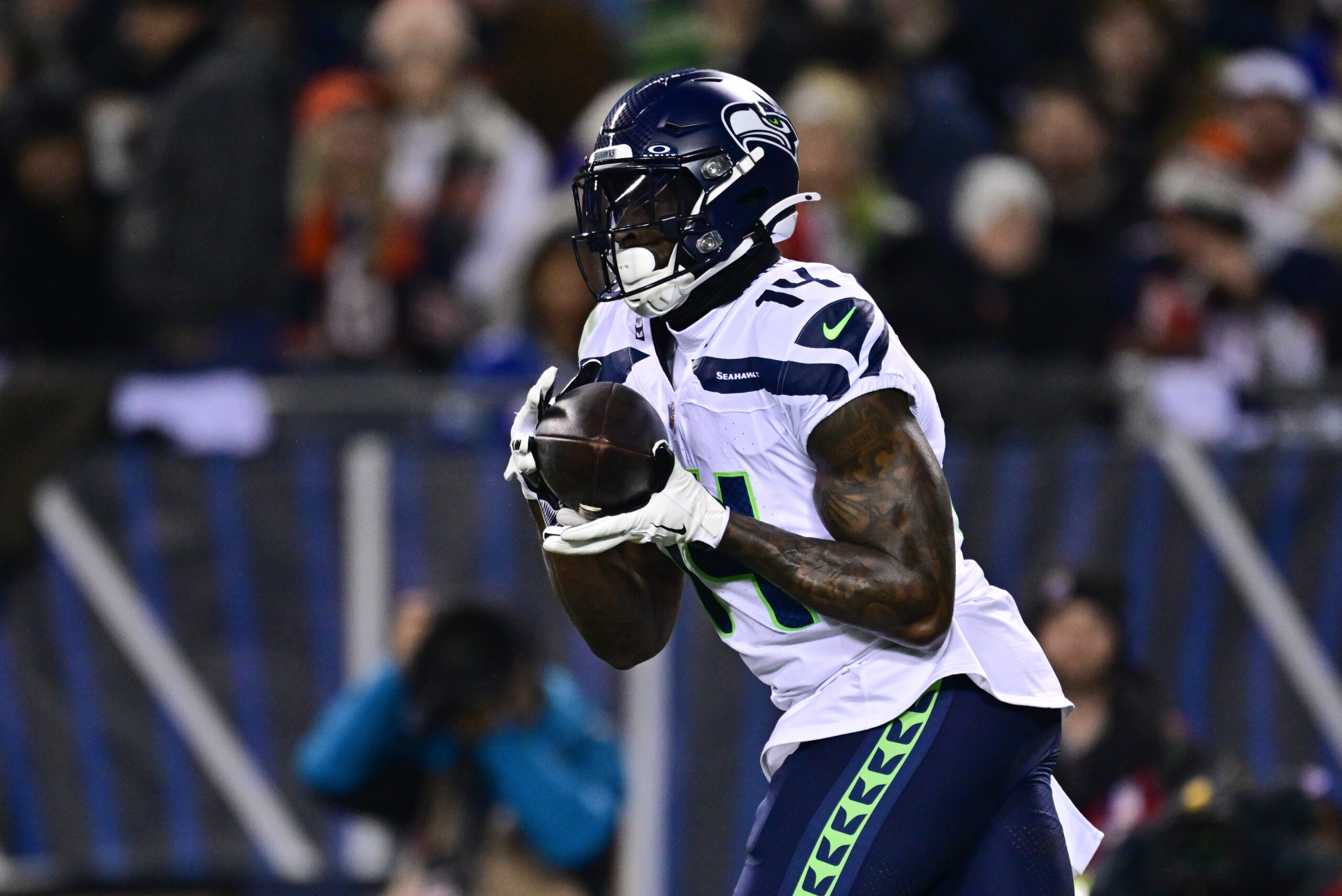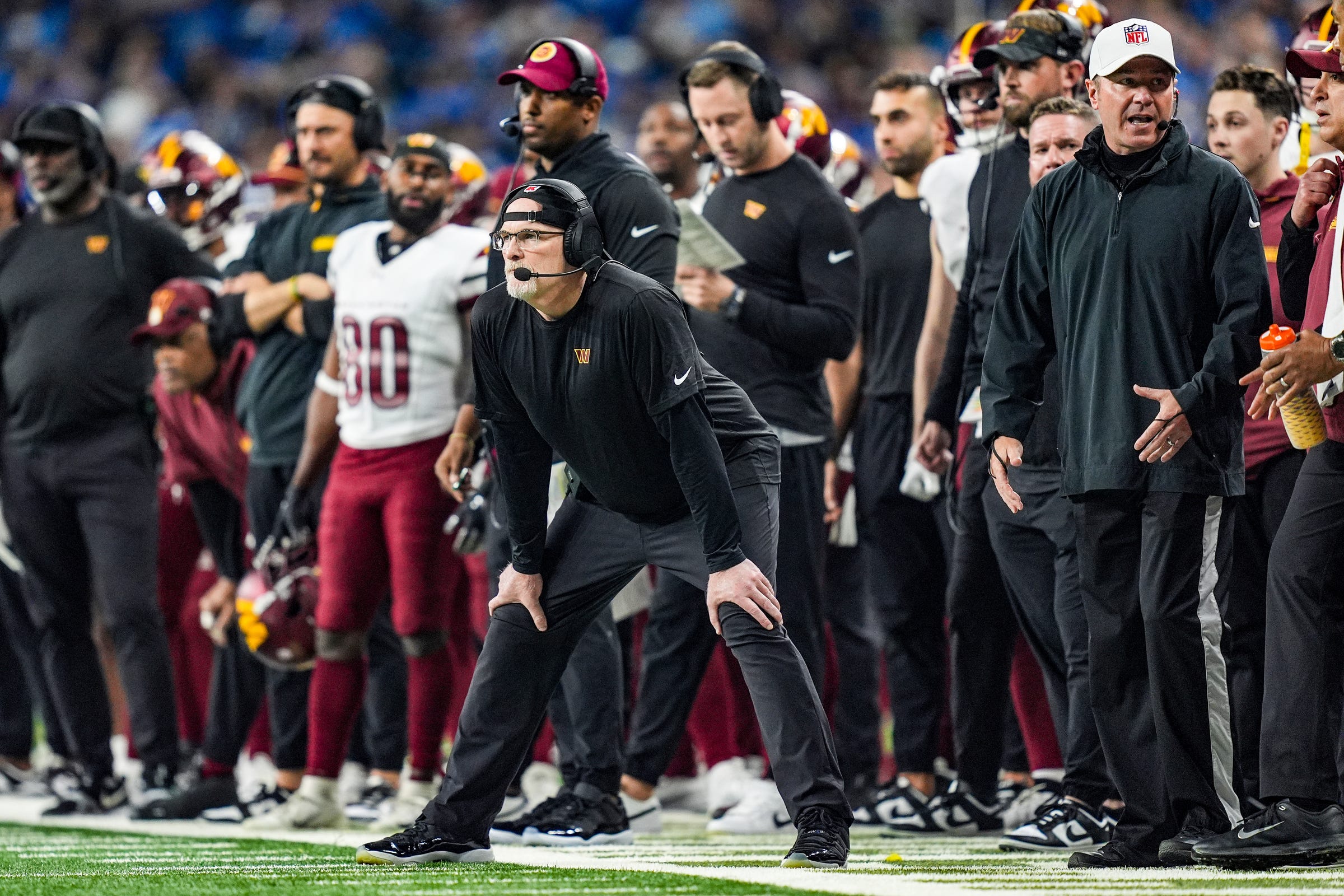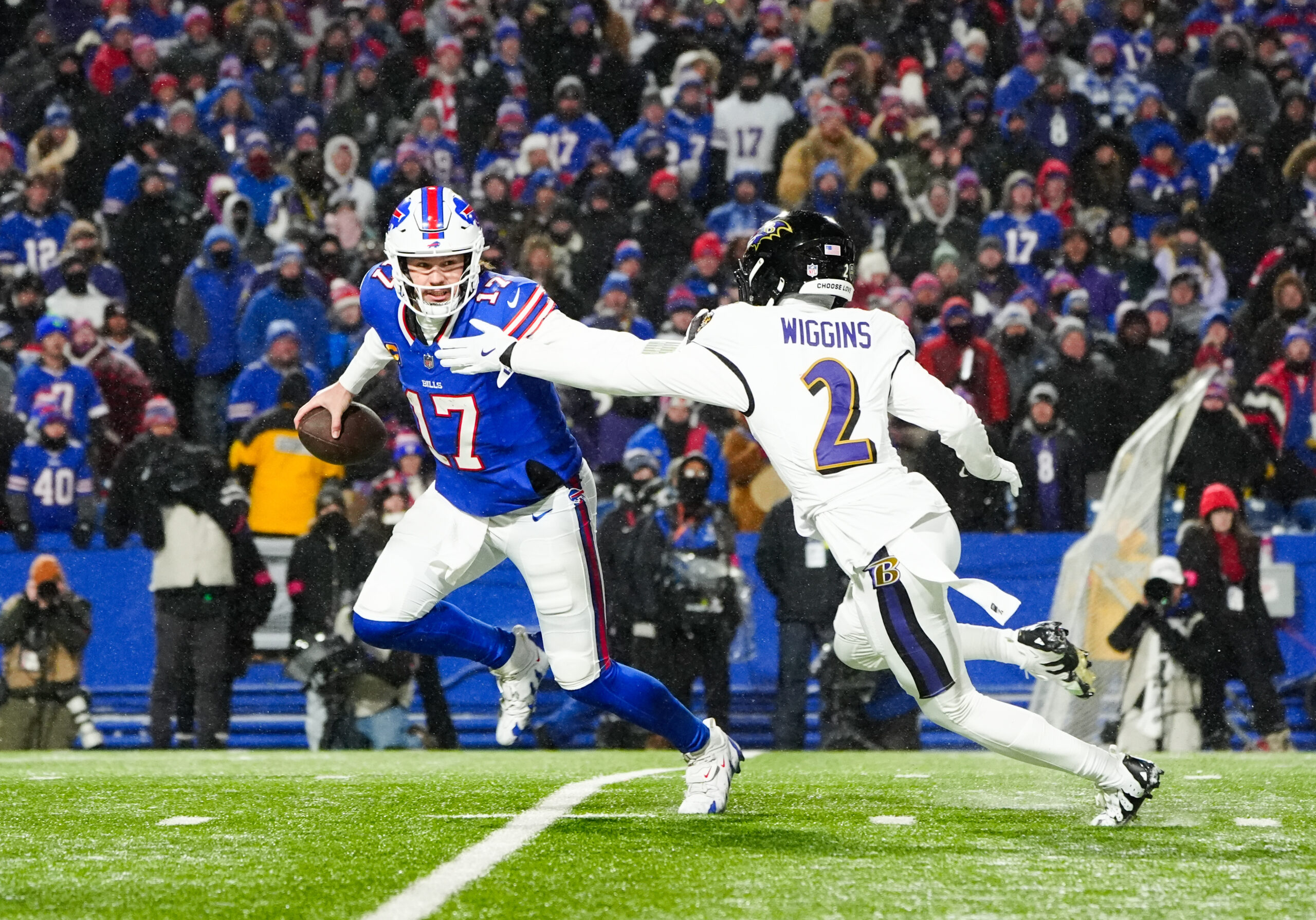NFL Analysis
9/23/24
21 min read
1st & 10 Week 3: Eagles Slow Saints, Flores vs. Stroud, A Rams Comeback & More

Each week, 1st & 10 will bring you an in-depth breakdown of everything you need to know from Sunday’s slate of games on Monday morning.
We’ll fill this column with stats, film, and plenty of words to keep you covered on anything you might have missed or want to dive deeper into from Sunday.
All stats provided by TruMedia unless noted otherwise.
1st & 10 NFL Week 3
1. The Eagles Slowed Down The Saints
Through two weeks, nothing could slow down the Saints. Their plus-62 point differential was the second-highest in the past decade, and their 93 points scored were the second-most since 2000. So, of course, the Saints found themselves in a low-scoring battle in Week 3, eventually losing 15-12 to the Philadelphia Eagles.
The Eagles were ready for what the Saints wanted to do, especially on first and second downs early in the game. New Orleans lived off play-action during the first two weeks of the season, using it on half of its dropbacks. With the Saints wanting to use play-action, they’ve also leaned heavily on the run.
New Orleans lost center Erik McCoy after three plays but kept the same game plan. The interior offensive line issues were amplified by going up against an interior defensive line that featured Jalen Carter.
Carter got into the backfield on an early play-action attempt that forced a rushed Derek Carr throw.
Jalen Carter. pic.twitter.com/uBQsf0uqo5
— Dan Pizzuta (@DanPizzuta) September 23, 2024
During this game, the Saints passed on 46.3 percent of their early down plays, the sixth-lowest rate of Week 3. That fit around what New Orleans did in the previous two games (37.1 percent early-down pass rate). The difference was that the Saints were winning big in those meetings and had success on the ground.
Philadelphia was ready to defend the run early and came out in base defense on 56.1 percent of early-down snaps. That rate was 11.8 percent for the Eagles during Weeks 1 and 3. The result was a 76.1 percent defensive success rate on early downs against the Saints and a 76.2 percent success rate against early-down runs.
The Eagles also shifted into a 6-1 front to make it tougher on the horizontal stretch of the Saints’ zone run game.
— Dan Pizzuta (@DanPizzuta) September 23, 2024
Throughout the game, Philadelphia had a late rotation that put another defender on the line of scrimmage, whether into five- or six-man fronts, to change the defensive structure right before the snap.
— Dan Pizzuta (@DanPizzuta) September 23, 2024
On early downs, the Saints averaged 3.8 yards per play — 3.0 per rush. That led to a ton of third downs and obvious passing situations where the Eagles could focus on rushing the passer. Philadelphia had a 50 percent pressure rate on third downs.
Pressure was also key here. Carr was pressured on 37 percent of his dropbacks against the Eagles after only seeing pressure on 19 percent of his dropbacks in Weeks 1 and 2. He avoided sacks, but the defensive front clearly impacted his play.
Even with the threat of pressure (and the weakened offensive line), Carr reverted back to the quick-throwing, short-passing version of himself. Carr had an average depth of target of 6.7 yards after an aDOT of 8.5 during the first two weeks and got the ball out in 2.55 seconds as opposed to an average of 2.77 seconds in Weeks 1 and 2.
With the shorter throws, many of them were in traffic without room to run after the catch. By keeping throws in front of them, the Eagles' defense was incredible at driving downhill for tackles. According to Next Gen Stats, the Eagles converted 94.7 percent of their tackling opportunities and missed just three.
Offensively, the Eagles showed how the depth of this lineup can shine. With A.J. Brown out and DeVonta Smith lost during the game with a concussion. Philadelphia leaned on Dallas Goedert and Saquon Barkley. Goedert finished with 10 catches for 170 yards on 11 targets, while Barkley had 17 carries for 147 yards and two touchdowns on the ground.
Goedert was a problem for the Saints early on. On a first-and-10 late in the first quarter from their 44-yard line, the Eagles came out in 13 personnel. The Saints brought a safety down to the box, and that left Goedert against Tyrann Mathieu deep. Goedert used his route to turn Mathieu around and create a big opening for a 43-yard gain.
— Dan Pizzuta (@DanPizzuta) September 23, 2024
Early in the fourth quarter, Goedert had a 30-gain on a crossing route on a third-and-5. The Eagles had trips to the opposite side and came out empty, with Barkley to Goedert’s side before the back motioned into the backfield. At the snap, Mathieu had to drive on Goedert’s route and missed a tackle.
Dallas Goedert crossing route goes for 30 yards on a third-and-5 early in the fourth quarter pic.twitter.com/bgJ8vs5iDz
— Dan Pizzuta (@DanPizzuta) September 23, 2024
When the Eagles had a third-and-16 with 1:18 remaining and down 12-7, they went to the same play but flipped it. This time, when the defenders tried to break on Goedert’s route, they ran into each other and left a wide-open side of the field for a 61-yard catch that set up the game-winning touchdown.
On Goedert's 61-yard catch with 1:16 left on third-and-16, the Eagles go back to the same play but flip it. pic.twitter.com/IvAVFzvDFO
— Dan Pizzuta (@DanPizzuta) September 23, 2024
Barkley closed the scoring with a four-yard touchdown run, but he also opened the scoring with a 65-yard run at the start of the fourth quarter.
Despite the Eagles holding down the Saints offense, Philadelphia trailed 3-0 heading into the final quarter. But this wasn’t just a boom-or-bust rushing day for Barkley.
This was the highest total rushing EPA in a game for his career. His 52.9 percent rushing success rate was the fourth-highest of his career, his best since the 2019 season when the other three top rates were set.

2. Brian Flores Wrecked C.J. Stroud
You’re probably wondering how C.J. Stroud got here:
Stroud was the latest victim of the Brian Flores Chaos Project. During the Minnesota Vikings’ 34-7 victory against the Houston Texans, Minnesota’s defensive coordinator had the second-year quarterback in hell for much of the game.
Flores has been a master this season of giving exotic looks up front and dropping into split safety coverages. Per Match Quarters, no team has disguised coverages from single-high to two-high more than the Vikings (21.4 percent). With all of that post-snap rotation, along with the pressure and high blitz rates, quarterbacks have struggled to figure out what is going on throughout Minnesota’s defense.
It’s nearly impossible to figure out exactly what’s coming. Take a look at Stroud’s first sack of the game in the first quarter. The Vikings line up with a five-man front. Houston motions a tight end to line up across from Jonathan Greenard.
At the snap, Andrew Van Ginkel drops off into coverage on the opposite side. With the line sliding that way, it leaves five offensive linemen blocking the three interior defenders. LB Blake Cashman (51) eventually rushes and gets a 1-on-1 with RB Cam Akers. Then, on the edge, Grennard blows by the tight end for the sack.
With so many defenders moving around, it’s hard to know where to go with the ball, and the quarterback’s internal clock speeds up. Stroud only threw 38.7 percent of his passes beyond the sticks against Minnesota, the second-lowest rate of his career. The lowest came in a comfortable 26-3 win against the Titans in Week 17 of last season. Stroud led the league with 51.1 percent of his throws passing the sticks in 2023.
Stroud was pressured on 40.5 percent of his dropbacks in the game. In the first half, that was due to a high rate of blitzing, as he was blitzed on 52.4 percent of his dropbacks. That dropped off in the second half to just 18.8 percent, but he was pressured more often.

Still, mixing up the fronts caused chaos for Stroud and the Texans’ offensive line. On Houston’s first offensive play of the third quarter, the Vikings showed a four-man front.
At the snap, Van Ginkel dropped off into coverage, and Harrison Smith rushed on the opposite side. This forced the right tackle to kick out to block Smith, and the right guard was not fast enough to get a hand on Greenard as he blew through the line for a sack.
That sack took just 2.5 seconds. On plays of 2.5 seconds or more, Stroud had a career-low 15.8 percent success rate.
Of course, Stroud is not the only quarterback to struggle against this Vikings defense, and he likely won’t be the last. The Vikings are fifth in defensive EPA per play through three weeks, though that feels low.
Minnesota might be the most frustrating defense to play this season because there is no telling what is coming. All the movement on the front is chaos for the offensive line, and the coverage remains sound behind it, with bodies constantly dropping from the line into coverage.
No team has played lighter personnel packages than the Vikings, who have used dime (six defensive backs) on a third of their defensive snaps. Against the Texans, that rate was 41.6 percent.
Yet, there are always Vikings around the line of scrimmage. Take a look at how often defenses play dime but also with a stacked box. Minnesota stands on its own.

Minnesota’s defense fell off last season because the lack of talent could not keep up with the chaos Flores was trying to create to make up for it. That is not the case this season.
The Vikings have the players to do whatever they want on defense, and they are taking full advantage of it. Combine that with an offense that can hit big plays with Sam Darnold in the passing game and Aaron Jones on the ground, and this has been one of the most complete teams through the first three weeks of the season — currently second in point differential.
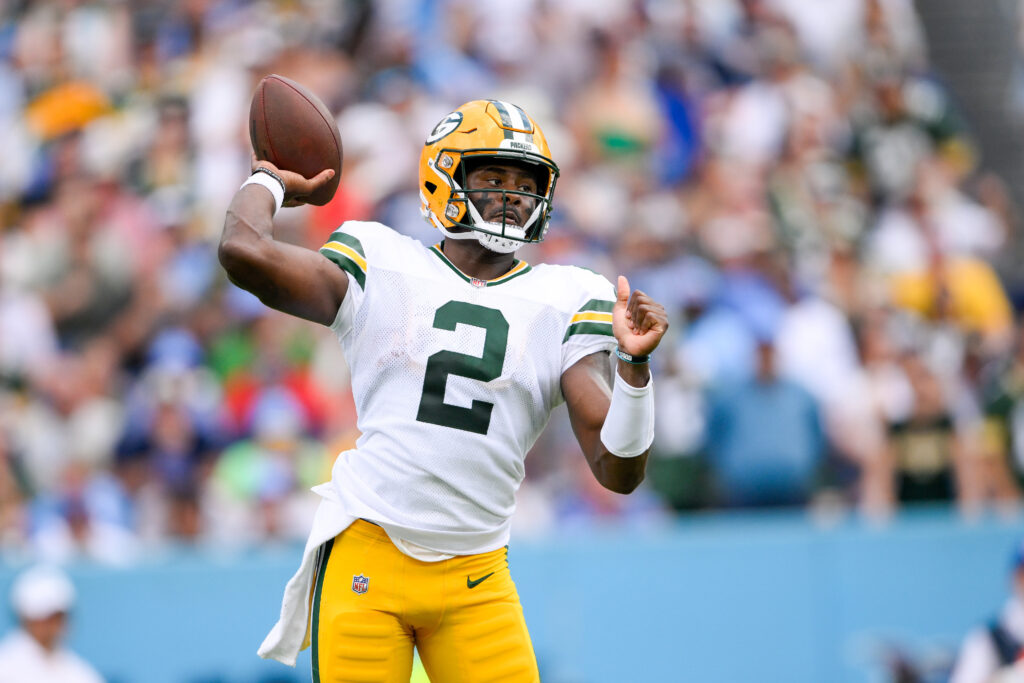
3. Matt LaFleur Keeps Working Magic With Malik Willis
If we’re talking about stellar coaching jobs in the NFC North, we have to talk about Matt LaFleur. After the wild rushing attack last week, the Packers continued to lean on the running game with a 28.9 percent early-down pass rate, but they had a much better and varied passing attack under Malik Willis as Green Bay defeated the quarterback’s former team, the Tennessee Titans 30-14.
Willis finished the game 13-of-19 for 202 yards (10.6 yards per attempt) and added 73 yards and a touchdown on the ground. He had a 92.6 QBR, meaning a team with a quarterback performance equivalent to Willis would be expected to win 92.6 percent of the time.
This wasn’t fathomable for any previous version of Willis, whether it was the college prospect or when he was in Tennessee. Since coming to Green Bay, there has been a clear shift in his confidence and play style.
The confidence is clear when Willis has needed to rely on himself in the pocket. On early down throws against the Titans, the Packers kept things simple. Willis got the ball out quickly and efficiently. But on third down, Willis stood in the pocket and made some throws.
Deep shots were expected to be a strength of Willis’ game when he came out of college because of his arm strength, but a willingness to stand in the pocket and deliver strikes to the intermediate middle of the field is not something Willis was doing, even in college. But he did against the Titans.
Even when Willis was scrambling, there was more control. This was his best professional game as a runner by yards, EPA, and success rate.
Putting Willis in a more controlled environment has allowed him to take advantage of his athleticism rather than using it to avoid pressure behind a poor offensive line — as it was during his time with the Titans — made him a more confident player.
In the past two weeks, Willis ranks 17th in EPA per play. That’s unbelievable for a player who was traded to Green Bay at the end of August for a seventh-round pick and looked overmatched when he had played in Tennessee.
The Packers likely wouldn’t be able to sustain an offense around Willis for an entire season, but they won’t have to. Jordan Love has been a limited participant in practice, and Green Bay tried to pretend he might play against the Titans. He should be back sooner rather than later.
When he is, the offense will be set up to succeed for whatever version of Love we see. Add that to a defense that leads the league in turnovers forced per drive (28.1 percent), and the Packers will remain a playoff contender as a well-coached team on both sides of the ball.

4. The Rams Came Back and Stay Alive
On a fourth-and-5 with 2:48 remaining, the San Francisco 49ers led the Los Angeles Rams 24-17 and had a 93.9 percent win probability, per ESPN Analytics. 49ers kicker Jake Moody lined up for a 55-yard field goal and missed.
The Rams' next play was a 50-yard pass from Matthew Stafford to Tutu Atwell, which took them to the San Francisco 5-yard line.
Two plays later, Kyren Williams had a 4-yard rushing touchdown to tie the game.
The next 49ers drive lasted five plays and went 15 yards in 1:09. On a second-and-10, Brock Purdy hit Ronnie Bell in the chest down the field, but the ball was dropped. Then, on third down, Purdy was forced to scramble and only picked up two yards.
When fourth-and-8 came up, the Rams had a 56.5 percent chance to win — a 50.4 percent swing in a minute and a half of game time.
Rams punt returner Xavier Smith returned the punt 38 yards to midfield. The Rams drew a defensive pass interference on first down and were set up for a game-winning field goal with two seconds left on the clock.
It was a wild win for the Rams, who came in hobbled with multiple starters missing on the offensive line and no Puka Nacua or Cooper Kupp. They were six-point underdogs at home. To make up for the absences, the Rams used 12 personnel on 43.6 percent of their offensive plays despite only having two active, healthy tight ends.
It was the eighth-highest rate of 12 personnel Sean McVay has used since becoming head coach of the Rams. Since he took over, the Rams have used 82.8 percent 11 personnel. His top nine games in 12 personnel have all come with good game plans, as the Rams have won all nine.

After a rough start, Matthew Stafford was excellent, averaging 0.37 EPA per play and 8.8 yards per attempt while being pressured on 60.7 percent of his dropbacks.
The Rams did not look like they would have a chance to win for most of the game because the San Francisco offense took over, even as that unit was missing Christian McCaffrey, Deebo Samuel, and George Kittle.
In their absence, Jauan Jennings had a game. Jennings is a big, physical player who does a lot of the dirty work for the 49ers as a blocker. He’s also a highly-targeted third down receiver. However, with the need to play more on early downs, Jennings had 11 catches for 175 yards and three touchdowns.

This win keeps the Rams alive, though at just 1-2. An 0-3 start would have been disastrous for a veteran team, but this win at least keeps some faith that a McVay-Stafford duo can be enough to keep the Rams in games until some semblance of health returns to the roster.
For the 49ers, this loss will sting. The Niners are now 1-2 in a year when many expected them to struggle following the Super Bowl loss. Still, that hasn’t been the case. While Kyle Shanahan is no stranger to blown late leads, there were no major mistakes that caused this blown lead.
While the Seahawks have gotten off to a 3-0 start, no one is running away in the NFC. The 49ers and Rams can come out of this game believing they can bounce back from a slow start.

5. Broncos Blitz & Beat Bucs
Entering Week 3, the Tampa Bay Buccaneers were on a hot streak and could do little wrong while the Denver Broncos were struggling to piece things together. Naturally, this turned into one of the biggest blowouts of the week, as the Broncos beat the Buccaneers 26-7.
Bo Nix had his best game as a pro, running an offense that looked more like the version that was promised in the preseason. He completed just 55.6 percent of his passes but was generally more accurate and decisive. He was also less jittery in the pocket, more confident when to run, and, despite averaging just 6.0 yards per attempt, had a QBR of 80.6.
The defense, though, continues to stand out. This is as aggressive a defense as we’ve seen for sending extra rushers. Through three weeks, the Broncos lead the league in blitz rate, bringing the blitz on early and late downs.

Denver is now first in pressure rate and sixth in defensive EPA per play. The Broncos got to Baker Mayfield and disrupted the timing of the Tampa Bay passing offense. Mayfield has been better in the pocket, something his passing improvement has been based on, but he was sacked seven times and rarely looked comfortable against the pass rush.
Mayfield was pressured on 40 percent of his dropbacks. While under pressure, he averaged 3.8 yards per attempt and -0.81 EPA per play.
The Broncos' defense also didn’t allow many of the easy answers the Buccaneers were getting in the first two weeks. Pat Surtain shadowed Mike Eavns on 24 of his 34 routes, according to Next Gen Stats, and allowed just one reception for eight yards when those two lined up across from each other.
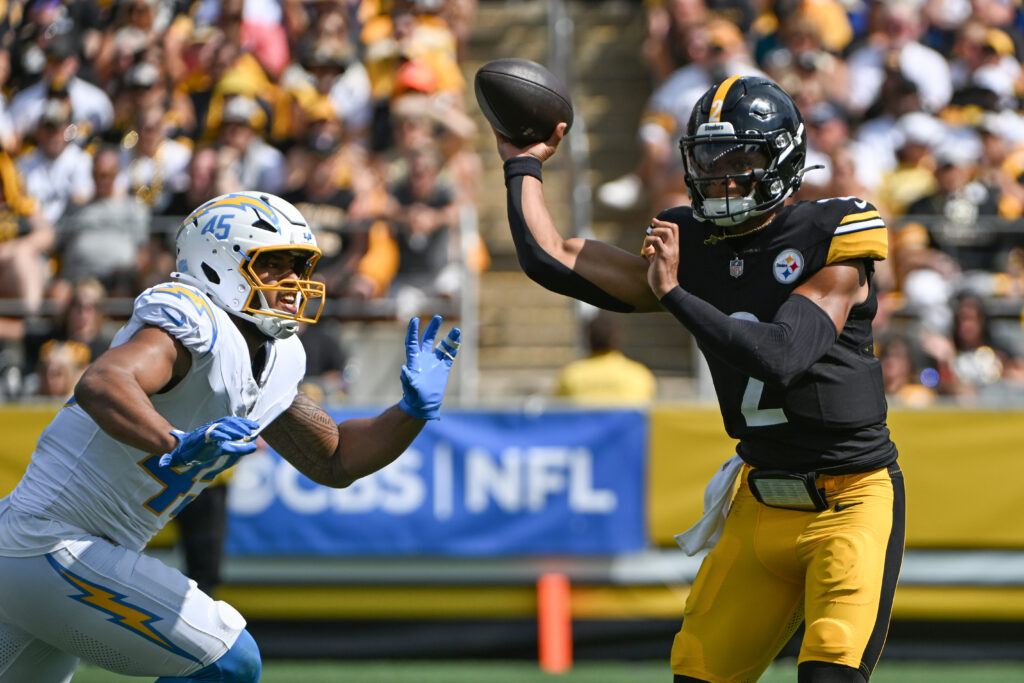
6. Justin Fields Has His Best Day As A Passer
In a 20-10 Steelers win against the Chargers, Justin Fields had his best passing day for Pittsburgh. While the Steelers are 3-0, the offense hasn’t been what’s gotten them there... the only team with a lower success rate through three weeks is the Cleveland Browns.
But Fields looked better in his third start, averaging 7.7 yards per attempt for a 55.4 QBR while hitting 0.0 EPA per play. Fields threw 32 times and dropped back 40. In that high volume, he didn’t seem lost or out of control.
The best parts of Fields’s performance were his throws to the middle of the field. That’s been an issue during his NFL career, but he was accurate and decisive against the Chargers. On throws between the numbers, he was 12-of-16 for 147 yards with a touchdown and an interception. On Fields’s passes between the numbers, his average time to throw was an impressive 2.27 seconds.
His 55-yard touchdown pass to Calvin Austin was a quick, decisive throw that got to the receiver before the safety had a chance to break on the ball.
Fields hasn’t been a revelation, but he continues to improve, and his skill set fits better with the Arthur Smith offense as both become more comfortable with each other. Given how limited Russell Wilson was the last time we saw him — and the fact that he’ll be coming off an injury — it’s hard to see the benefit of naming Wilson the starter once he’s healthy.

7. Carolina Looked Good With Andy Dalton
If anyone was wondering if the quarterback was the biggest problem in Carolina, it didn’t take long to get an answer. This isn’t to say the Panthers will now be some model franchise because of Andy Dalton, but at least it’s proof the on-field product isn’t completely broken.
In a 36-22 win against the Las Vegas Raiders, Dalton looked good. Like legitimately. He made some throws that wouldn’t be expected of prime Dalton back in his Bengals days.
We shouldn’t expect that level of play for the remainder of the season, but we did get to see proof of concept for the Dave Canales offense and the investment made in the players surrounding the quarterback.
Dalton finished with 319 yards and three touchdowns, good for 0.34 EPA per play (a rate Young has not hit with a career-high of 0.26). Dalton got the best game out of Diontae Johnson, who was active in the middle of the field and ended the game with eight catches, 122 yards, and a touchdown on 14 targets. Adam Thielen and Xavier Legette were also useful pieces — Thielen had a touchdown, and Legette had a 35-yard catch.
This helps the Panthers figure out what the issue is, but while that might solve the current question, it leaves more for the future — especially with reports earlier on Sunday that multiple teams inquired about Young’s availability.
8. Chart of the day

Malik Nabers had eight catches for 78 yards. Those numbers don’t completely stand out on their own but how he did it is worth exploring. Nabers had a catch that took a would-have-been interception away from the Cleveland Browns and had another that turned a likely overthrown incompletion into a touchdown.
Nabers, as a rookie, leads the league in target share (37.8 percent — more than five percent ahead of the next-highest receiver) and has the most receptions of 20 or more yards (six).
Daniel Jones is averaging 0.52 EPA per play when throwing to Nabers and -0.20 EPA per play when targeting anyone else.
Nabers is single-handedly lifting the Giants' passing offense, and we haven’t even gotten a monster takeover game from him yet.
9. Play of the day
Hook and ladder plays are great, and there should be more of them.

10. Is the Dallas defense fixable?
The Dallas Cowboys are 30th in EPA per play on defense.
After Week 1, the Dallas defense looked stronger than last year after a dominating performance against the Cleveland Browns. It turns out the Cleveland offense is quite bad. The Cowboys hit Deshaun Watson 17 times… but the New York Giants just did it 14 times, so that might just be a thing for Browns opponents this season.
The biggest issue is the run defense. Dallas has the worst success rate against the run this season, and it is the only team in the league below 50 percent. The Cowboys let the Saints run all over them last week.
That continued with 274 rushing yards allowed to the Baltimore Ravens in a 28-25 loss that was not as close as the final score would indicate.
Derrick Henry had his way running through holes and through defenders. He averaged 2.04 yards before contact and four yards after contact per carry. Henry had 20 percent of his attempts go for more than 10 yards, while just eight percent of his runs were stuffed at the line.
Dallas is 31st in rushing yards allowed before contact through three weeks. There is not enough size and strength in the interior of the defensive line. That was also a problem last season, but the pass defense was so good it did not make as much of an impact. That has also not been the case this year.
The Cowboys are just 15th in pressure rate and have not held up as well in coverage. Lamar Jackson was 12-of-15 for 12.1 yards per attempt against Dallas in Week 3.
If Dallas can’t stop the run and still allow for big plays in the passing game, it will be a nearly impossible lift for Dak Prescott and the offense to overcome — we saw they could only get so close on Sunday.



